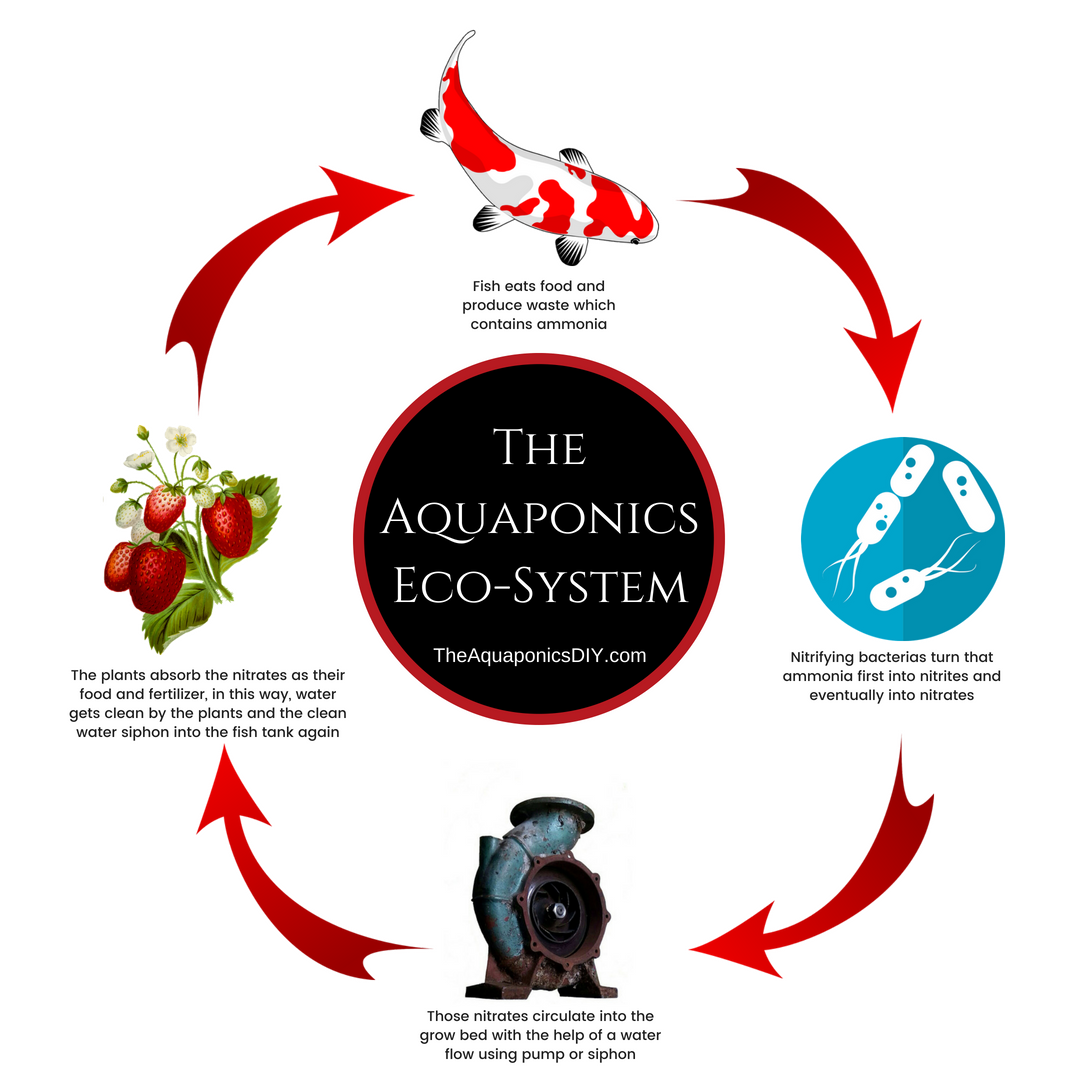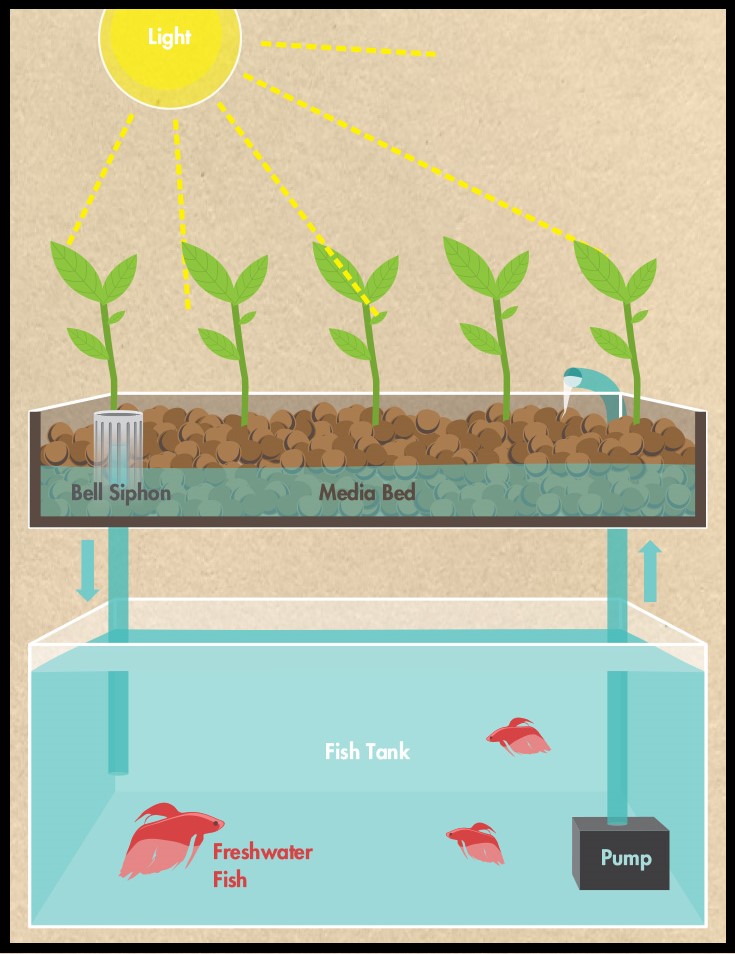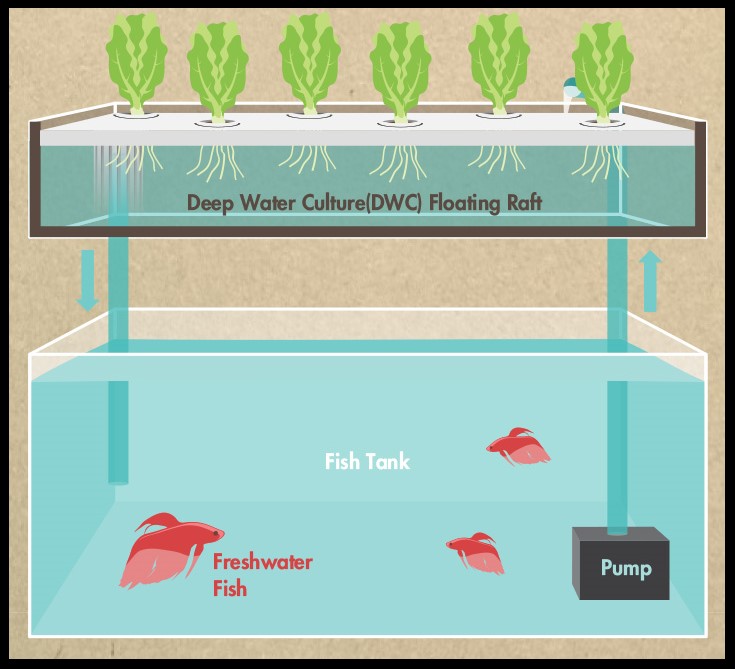Do you want to know everything about aquaponics farming?
Are you digging the whole internet but could not find the required information on a single website?
If your answers to my questions are YES! Then I must say that you are in the right place.
I know that the pieces of information about the aquaponics farming system are shattered on the internet here and there.
But now you don’t need to worry, because I have tried to answer almost all the possible questions about the aquaponics in this single article alone.
So please move forward and enjoy the reading.
What Is Aquaponics?
Aquaponics is the combination system of aquaculture (a method of raising aquatic animals like fish and prawn in the tank) and hydroponics (a method of growing plants on the water without any soil) in a symbiotic habitat.
Aquaponics system creates the cycles of an ecosystem where aquatic animals, nitrifying bacterias, and the plants indirectly get benefited by each other to survive and grow inside that artificially created environment.
(1) Age Of Aquaponics Development
Growing fish and vegetables together in an integrated ecosystem is not a new thing, it is an ancient technology to grow foods for the living.
Although we have no proper evidence of its first occurrence, still we can consider some places where the ancient forms of aquaponics developed.
According to Wikipedia:
“Aztec cultivated agricultural islands known as chinampas in a system considered by some to be the first form of aquaponics for agricultural use.”
Also,
“South China and the whole of Southeast Asia, where rice was cultivated and farmed in paddy fields in combination with fish, are cited as examples of early aquaponics systems,
although the technology had been brought by Chinese settlers who had migrated from Yunnan around 5 AD.”
Last but not least,
The 13th century Chinese agricultural manual Wang Zhen’s Book on Farming (王禎農書) described floating wooden rafts which were piled with mud and dirt and which were used for growing rice, wild rice, and fodder.
(2) Inventor Of Modern Aquaponics
The modern aquaponics development often attributed to the New Alchemy Institute and Dr. Mark McMurtry for the reciprocating aquaponics techniques.
After that in the year of 1979, Dr. James Rasogi and his colleagues researched and invented the large-scale aquaponics system using deep water culture hydroponic grow beds at the University of the Virgin Islands.
(3) Originate Place Of Aquaponics
The ancient Aztec people who lived in central Mexico at about 10,000 AD invented the ancient aquaponics system.
Back then they used to raise the plants on rafts made by the waste materials on the surface of lake shallows.
(4) Place Where Aquaponics Rising In Popularity
China is popular for using so many floating aquaponics systems and some of them are on the largest (2.5 acres) polyculture fish ponds to grow rice, canna, lily, wheat, and other crops.
In the most recent years, China is growing so fast in this aquaponics field just like all the other fields, as it seems like they don’t want to stay behind in the technology field.
How Does Aquaponics Work?

Aquaponics is a system where fish eats food and produce waste which contains ammonia, then nitrifying bacterias turn that ammonia first into nitrites and eventually into nitrates,
those nitrates circulate into the grow bed with the help of water flow using pump or siphon, and then the plants absorb the nitrates as their food and fertilizer,
in this way, water gets clean by the plants and the clean water siphon into the fish tank again.
This process of water recirculation goes over and over again.
What Can Aquaponics Grow?
There are usually two main things we can grow in the aquaponics system (i) Plants & (ii) Aquatic Animals.
So in this section, I will tell you what vegetables and aquatic animals can be produced in aquaponics farming.
(i) Plants
Plants for the large and established aquaponic system:
- Cabbage
- Peppers
- quashes
- Bean
- Cauliflower
- Pea
- Broccoli
- Tomato
Suitable plants for the general aquaponics system:
- Leaf cabbage
- Bok choy
- Basil
- Chives
- Arugula
- Watercress
- Mint herb
- Chard
- Common houseplants
- Almost all kinds of leaf lettuce
(ii) Aquatic Animals
- Koi
- Tilapia
- Bluegill
- Crappies
- Sunfish
- Catfish
- Barramundi
- Largemouth Bass
- Golden perch
- Silver perch
- Yellow perch
- Carp
- Pacu
- Common Mollies
- Angelfish
- Swordfish
- The Guppies
- Tetras
- Fancy goldfish
- Crayfish
- Prawns
Types of Aquaponics
According to the experts, there are mainly three types of aquaponics farming systems exists (1) Nutrient Film Technique (2) Media Beds (3) RAFT or Deep Water Culture.
(1) Nutrient Film Technique (NFT) Aquaponics

The Nutrient Film Technique (NFT) is a method of aquaponics, where we can grow only the sensitive plants such as leafy green plants in the holes of a long narrow pipe or channel, in which the nutrients flow with the shallow moving water flow to feed and fertilize the plants.
(2) Media Bed Aquaponics

The Media Bed is a method of aquaponics, where we create the grow beds with the full of media such as gravel or clay beads to anchor the plant roots to hold and keep the plants in the same place,
therefore nutrients along with the water pumps or siphons (with the help of gravity) into the grow beds to feed and fertilize the plants.
(3) RAFT or Deep Water Culture Aquaponics

The RAFT or Deep Water Culture is a method of aquaponics, where we grow the plants in the small containers punching on the holes of floating polystyrene boards (raft) on the water surface of the fish tank,
where the roots of the plants can easily absorb the nutrients from the fish tank water directly.
Benefits of Aquaponics
There are many benefits of aquaponics farming that you are going to learn in the below sections.
(1) Easy to Set Up & Maintain
Aquaponics system seems like a complicated form of farming which is not true,
because at the initial level you just have to set up and establish the greenhouse and the aquaponics system once and then you are ready to grow and harvest the foods regularly.
There are two options to set up an aquaponics system, either you can purchase a readymade system or you can create it yourself.
If you want to create the system yourself then this blog a dedicated place for you to learn everything about the aquaponics do it yourself methods.
But if you don’t want to get into the technical stuff, then there are some dedicated organizations exist who will set up everything for you as well as provide you the basic training to operate the aquaponics system.
Maintenance of the aquaponics is much easier because you just have to feed the fish from time to time and monitor the plants,
other than that you just have to control the water parameter and keep track of the motor, as well as if the entire system is working fine or not.
(2) Less Manpower Required
The best part of aquaponics farming is that you won’t require a lot of manpower to maintain the system, and the main reason behind that it is not having the soil, fertilizer, pests as like traditional farming.
So there is no extra manpower needed for seeding, planting, cultivating, compost shredding fertilizing, manure spreading, etc.
If you want you and your family members alone can take care of the entire aquaponics system in the free time without hiring any additional staff from the outside.
(3) Produce Organic Fish & Vegetable
Aquaponics is a sustainable farming system where you can organically produce fish and green vegetables because you cannot use pesticides in this farming method that is the reason it produces healthier and fresh foods.
The best part about aquaponics farming is that you don’t even need the fertilizer nutrient from outside to feed the plants because in this system fish produce waste which is used as fertilizer nutrient for the plant,
in this way water gets filtered by the plants and then fish get fresh water for the healthy living.
(4) Less Space Requirement
One of the best advantages of aquaponics is that it takes almost five times less space than traditional farming which is unbelievable.
In the aquaponics system, you can produce five times more foods than a normal soil farm, as well as you can grow more than one type of crop at the same time, while it is not possible even on the hydroponics farming system.
In hydroponics farming, every individual crop needs a different nutrient level that is the reason you can grow only one crop at a time in the hydroponics system.
Whereas in the aquaponics system, you can grow many different kinds of crops at the same time, because it doesn’t contain any chemical and produce nutrient from the fish waste,
so the environment of this system is suitable for all kinds of crops as the system works like a natural ecosystem.
(5) Less Water Usage
As compared to traditional farming, aquaponics requires only 10% of water.
As we all know that the water we use in soil farming goes into the ground where 90% of water gets wasted,
whereas in aquaponics farming we don’t waste any water because we recirculate the same water in the system permanently.
Even in the hydroponic system water needs to be replaced after a while, but in the aquaponics, you just put the water in the beginning, therefore the same water will be there forever.
In the aquaponics system from time to time, we just required to add some water to the fish tank because the plant absorbs some water and a few amounts of water evaporate,
other than that there is no additional wastage of water, and we can use the same water permanently in the aquaponics system.
(6) Produce Out of The Season Crops
Growing vegetables out of the season are the very tough task for the farmers which requires the chemicals and controlled conditions,
therefore out of the seasoned vegetable become more expensive and even they don’t taste as good as when growing them on the season.
But if I talk about the aquaponics then I must say that it’s a value for money investment because in the aquaponics system you can produce many out of the season vegetables easily,
and the taste of those vegetables are just like the normal vegetables that are growing in the season.
(7) Use it For Commercial Purpose To Make Money
It is not necessary to grow the foods in the aquaponics system for your household purposes only, you can produce foods commercially by scaling the system to create a profitable and successful business around it.
Suppose, if you can produce fish and vegetables on a large scale then you can easily sell those in the local market, grocery store, restaurant and even from your home.
There is always a demand for fresh vegetables and fish, especially when you grow them organically and out of the season.
If you can fulfill the market demand then you can easily make a lot of money out of it.
Although there are a good scope and scalability in this business model, still before jump into this, you must do the market research and analyze your own.
(8) Harvest Faster
In the aquaponics system, we grow plants in the water without using any soil and chemicals, in this way we able to eliminate all the soil-based diseases which can affect plant growth.
Instead of using chemical nutrients, we use high nutritious fish waste which contains all the required components that help plants to grow even faster than traditional soil-based farming.
(9) Eco-Friendly & Sustainable
Aquaponics is an eco-friendly and sustainable farming system because the plants grow in the natural condition without any chemical fertilizer with the help of waste produced by the fish,
as a result, in this system we able to produce 100 percent fresh, organic and healthy foods.
Some additional ecological benefits are proven and most important for all of us.
Toxic-Free Crop Production
This is a natural condition to grow crops where we do not use any chemicals and fertilizers,
that is why we successfully able to eliminate the cause of nutrients deficiencies and toxic effects which can harm the plants and even can kill them.
In simple words, we can say that we produce toxic free healthy foods in the aquaponics system.
Energy Savings
Aquaponics system only needs electrical energy as compared to traditional farming, where we need petroleum fuel as well as the electrical energy,
which can cost more because we cannot produce fuel locally, therefore we have to ship it from the oil supplying countries.
But we can use easily generated electrical energy from the solar panel or any other resources that produce energy locally and could cost almost half of the other energies used in traditional farming.
Preservation of Water
I already told you earlier in this article that aquaponics uses almost 90 percent less water than the other farming methods.
In this system, we use the same water in the farming cycle over and over again without wasting any water, which can be helpful for those regions where we face problems with water availability.
River Pollution Control
In traditional farming, we generally use a lot of fertilizers and pesticides in the soil, and those things always go to the rivers with the flow of water, and at last, as the result that pollute our rivers and lakes.
But in the aquaponics system, we don’t pollute any river or lakes, because we never use any fertilizers and pesticides in this method of farming.
Aquaponics Is The Future of Farming
The aquaponics has a bright and promising future in the field of farming because you can successfully start and run aquaponics farming anywhere easily as compared to traditional farming, which requires a dedicated environment, land and many resources.
But you can easily grow vegetables and fish in the aquaponics system, in an environment with fewer resources even in areas which have environmental issues like drought,
as it requires 90 percent less water than traditional soil-based farming, as well as less water than the hydroponics farming.
(1) Aquaponics vs Traditional Farming
There are countless benefits of aquaponics farming over traditional farming and in this section, I am going to introduce some very important benefits of aquaponics over traditional soil-based farming.
Organic Growth
Aquaponics is the 100 percent organic farming method, where no one can use any kind of chemical pesticides or the fish would die.
Therefore if an aquaponics farmer is claiming that their grown foods are fresh and organic then you can believe in them, because even an approved organic pesticide can kill their fish which forces them never to use any of them.
Soil & Watershed Protection
Even soil-based organic farming requires fertilizers and chemical pesticides to increase the growth potential of the land which ends up polluting the soil and watersheds.
However, there are no such issues you can find in the aquaponics farming as it neither needs soil nor the water needs to be through away.
Land, Location & Climate
Since aquaponics farming doesn’t require soil-based fertile land to grow foods, therefore you can start it anywhere in any climate and environment, which is not possible in the case of traditional farming.
Aquaponics can grow almost 5 times more crops than traditional farming which simply means it needs 5 times less space than the general soil-based farming.
The best part about aquaponics is that you can start growing foods in cities even commercially, therefore, you can supply fresh foods in your locality which is good for everyone.
Water Protection
Aquaponics requires 90 percent less water than soil-based farming because it uses the same water in the recycle mode by filtering the dirty fish water with the help of nitrifying bacterias and the plants over and over again.
Resources Usage
Traditional farming needs a lot of labor for sowing, taking care, fertilizing, pesticide spreading and harvesting purposes where aquaponics is soil-less farming,
therefore, it requires only 30 percent labor resource as compared to traditional farming.
Traditional farming needs the petroleum fuel to run the tractor on the land for plowing, and it also requires the electrical energy for the water supply motor in most of the cases,
whereas, aquaponics only requires the electrical energy, which we can produce even locally using solar panels or wind turbine.
(2) Aquaponics vs Aquaculture
Aquaculture is the method of fish farming where we do breeding, rearing, and harvesting of aquatic animals for food, and it is also used as a part of the aquaponics system to grow fish and vegetables at the same time.
Water Preservation
In the aquaculture fish produces a higher amount of ammonia which become nitrite and eventually nitrate with the help of nitrifying bacteria, which is not good for fish and aquatic animals,
therefore, we need to filter the water which can be too costly or simply just we can replace the water and threw it away, in this way it wastes a lot of water.
But in the aquaponics system, you neither have to put the extra money to clean the water nor you need to replace and waste because in this system plant absorbs all the nitrates produced by the fish and bacterias and the water gets filter free of cost.
Maintenance Cost
Aquaculture requires a lot more maintenance cost because of water purification and replacement cost,
as well as you would also need various types of medicines for water quality management, disease treatment, probiotics, and antibiotics, etc.
Whereas in the aquaponics system, fish and plants develop a natural symbiotic environment where both get benefitted by each other, therefore we don’t require any additional maintenance cost for water purification or medicines.
Crop Varieties
Although you can grow many kinds of fish in aquaculture still you can harvest only fish in this system, whereas in the aquaponics system you can grow fish and vegetables at the same time.
(3) Aquaponics vs Hydroponics
Hydroponics is a system where only water and nutrients have been used to grow and harvest many kinds of vegetable plants in greenhouse farming.
Now if you talk about the aquaponics system then it grows plants and fish at the same time using hydroponics as a big part of the system.
So in this section, I am going to explain some important benefits of aquaponics over hydroponics farming.
Organic Growth
In the hydroponics, we use many chemicals, salt and made up nutrients to feed the plants, and to create the artificial ecosystem to grow the plants.
Whereas in the aquaponics system fish produce all the necessary food fertilizers for plants and it works like a natural ecosystem.
Supply of Nutrients
In the hydroponics, we require to use chemical nutrients to fertilize the plants which are very costly to purchase, therefore it affects the cost of crops.
On the other hand in the aquaponics system, we just require fish foods,
after that, the fish and bacteria create natural nutrients, which is a low-cost investment for the nutrients supply as compared to the chemical nutrients used in the hydroponics.
Maintenance
Hydroponics system requires extra attention daily to check electrical conductivity,
whereas in the aquaponics system you just need to check PH and ammonia levels on weekly and nitrate level monthly,
because the ecosystem keeps maintaining the balance for each other.
Productivity
According to the experts, in aquaponics, we can grow plants more efficiently and faster than the hydroponics system,
however, it needs at least half a year to well established the biofilter of the aquaponics system but it is still worthy.
Toxic Level
After a certain period, you would need to replace the water of the hydroponics system as the toxic levels increase because of the chemicals and salts used in the system.
But in the aquaponics system, you would not require to use any chemicals in the water, therefore, it is toxic free water recycling natural process.
(4) How Aquaponics Changes The Game
Aquaponics is a long-term play and future of modern farming technology, and as per my opinion, it has the potential to change the game.
On the above, I have explained the advantages of aquaponics farming over three different kinds of farming methods.
Hopefully, now you have understood that the aquaponics system is a perfect combination of hydroponics and aquaculture systems altogether.
If you want to start aquaponics farming then you will learn to grow fish and other aquatic animals which is a part of aquaculture,
and on the other hand, you will also learn the soilless farming using water which is a part of hydroponics.
So in the end, you will end up learning both the aquaculture and hydroponics methods at the same time in the form of aquaponics farming system,
which is the more efficient and eco-friendly farming method at the same time.
Set Up Your DIY Aquaponics System
If you went through this entire article I assume that you are quite interested in setting up your DIY aquaponics farming system in your place.
I would not suggest you dig the internet to find more details to set up your DIY aquaponics system,
however, you can find some useful videos related to aquaponics on YouTube.
As I already researched a lot about the aquaponics farming system, and I did not find any single organized site where you can learn everything about this entire topic in one place.
Therefore I decided to create this website to provide complete knowledge about aquaponics in a well-organized way in one place.
So I recommend you to bookmark this site to access all the information that I would share through my blog posts.
Conclusion
I hope you enjoyed reading this article on everything about the aquaponics farming you need to know about.
Now, very soon I am going to share more articles on different topics about the aquaponics DIY.
In this article, I have tried to provide as much information about aquaponics farming as I could,
however, if there might be something that you may notice I missed out, then kindly share your opinions and feedback in the below comment box,
I would try to reply to the comment made by you.
Thank you so much for reading.
